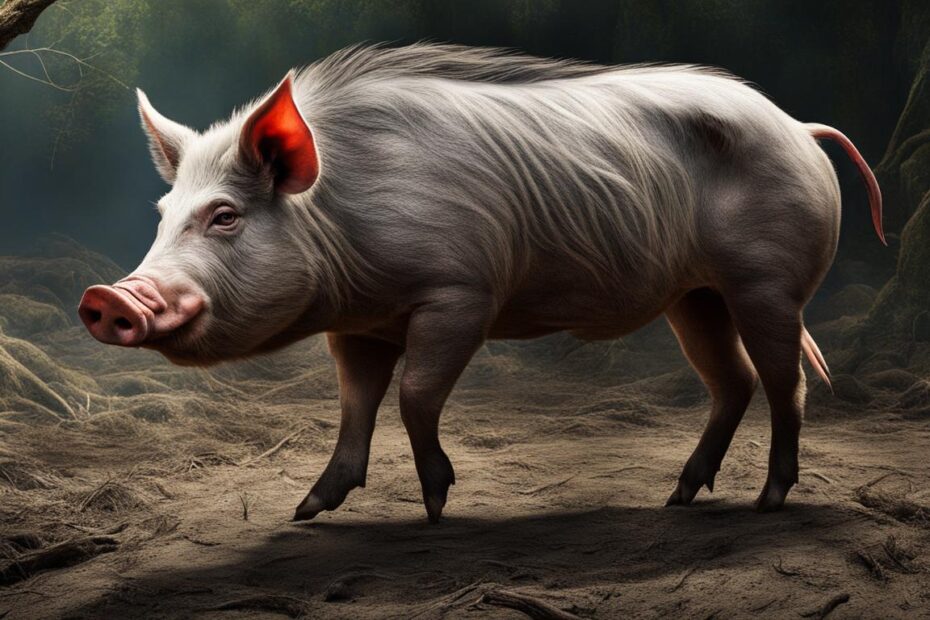Feral pigs, also known as feral swine, are formerly captive pigs that have reverted to the wild. They can be Eurasian boars, other exotic pig breeds that have escaped from game ranches, or domestic hogs that have become feral. These adaptable creatures quickly adjust to their new environment and can become aggressive. Feral pigs tend to follow creeks and drainages between food sources, and they have a voracious appetite, eating anything they can fit in their mouths. However, their presence comes at a cost – feral swine cause significant damage to crops, wildlife, and the environment.
Key Takeaways:
- Feral pig transformation occurs when formerly captive pigs revert to the wild.
- Adaptability and aggressiveness enable feral pigs to survive and thrive in the wild.
- Feral pig populations cause damage to crops, wildlife, and the environment.
- Efforts are being made to control feral pig populations through hunting and regulation of game ranches.
- The spread of feral pigs poses a threat to ecosystems, agriculture, and public health.
What Causes Pigs to Go Feral?
Pigs have a fascinating ability to transform from domesticated animals to feral hogs when they escape or leave captivity. This transformation is driven by a combination of genetic factors and environmental influences. When pigs live in a wild environment, the genes from their wild ancestors are activated, triggering the pig’s transition to a feral state. Some scientists argue that domesticated pigs remain unchanged even if they escape, but they may undergo morphological changes due to variations in their environment and genetic makeup.
Understanding the transformation from domesticated pig to feral hog is a complex process. It involves hormonal changes and behavioral adaptations. When domestic pigs are introduced to the wild, they experience stressors such as predators and competition for resources, which can trigger hormonal fluctuations. These hormonal changes, along with the influence of genetic factors, lead to morphological alterations in the pigs and the development of feral traits.
The process of pig transformation from domestic to feral is a unique phenomenon that showcases the adaptability and resilience of these animals. It also underscores the importance of effective management strategies to control feral pig populations and mitigate their impact on ecosystems, agriculture, and public health.
Factors Contributing to Pig Transformation:
- Genetic influence from wild ancestors
- Environmental conditions and variations
- Hormonal changes triggered by stressors in the wild
- Behavioral adaptations to survive in the wild
“The transformation from domesticated pig to feral hog is a complex process that involves hormonal changes and behavioral adaptations.”
The Genetic Factors Behind Feral Pig Transformation
When it comes to the transformation of domestic pigs into feral hogs, genetics and the environment play significant roles. The expression of specific genes in pigs determines their physical appearance, and this gene expression is influenced by the pig’s environment. In the case of feral pig transformation, the genetic phenomenon of neoteny also comes into play. Neoteny refers to the retention of juvenile characteristics in animals, which can be influenced by environmental factors. In the case of domesticated pigs kept in controlled conditions, their testosterone levels remain low. However, when these pigs are introduced to the wild and face stressors such as predators and competition for resources, their hormonal levels change. This hormonal shift leads to morphological changes and the development of feral traits.
To understand the genetic factors behind feral pig transformation, it is crucial to delve into the complexity of pig genetics. Domestic pigs have wild ancestors, and the genes from these ancestors become activated when pigs escape or leave captivity. This activation triggers the transformation process, allowing pigs to adapt to a wild environment and develop feral characteristics. While some scientists argue that domesticated pigs remain unchanged even if they escape, there is evidence to suggest that environmental variations and genetic makeup can lead to morphological changes in these pigs. The interplay between genes and the environment is a key determinant in the transformation of domestic pigs into feral hogs.
Overall, the genetic factors behind feral pig transformation highlight the dynamic nature of these animals. Their ability to adapt to different environments and undergo physical changes is a testament to their resilience and evolutionary history. By understanding the genetic underpinnings of feral pig transformation, researchers and conservationists can gain insights into how to effectively manage and control feral swine populations, mitigating their impact on agriculture, ecosystems, and public health.
| Genetic Factors | Environmental Factors | Implications |
|---|---|---|
| Gene expression | Neoteny | Activation of specific genes determines the physical appearance of pigs |
| Genes from wild ancestors | Environmental variations | Escape or leaving captivity triggers the transformation process |
| Competition for resources | Morphological changes and development of feral traits occur in response to stressors |
The Spread and Impact of Feral Swine
The feral swine population has been rapidly spreading across North America, causing significant damage to the environment, agriculture, and native wildlife. These highly adaptable and destructive animals have become a major concern for landowners, farmers, and conservationists alike. Efforts to control and manage feral pig populations have become imperative in order to mitigate their impact and prevent further expansion.
One of the primary concerns with feral swine is their destructive foraging behavior. They trample and root up land, causing erosion and habitat destruction. Feral pigs can eat anything they can fit in their mouths, including crops, native plants, and the eggs of ground-nesting birds. This not only affects agricultural productivity but also disrupts ecosystems and threatens the survival of native species.
To address the issue of feral swine, various methods are being employed, including feral swine extermination, habitat modification, and management strategies. Extermination methods involve lethal approaches such as hunting, trapping, and poisoning. Habitat modification aims to limit their access to food sources and breeding areas by implementing fencing, creating barriers, and removing or altering their habitats. Additionally, management strategies focus on reducing feral pig populations through targeted hunting and trapping programs.
| Methods | Description |
|---|---|
| Feral Swine Extermination | Includes lethal methods such as hunting, trapping, and poisoning to eliminate feral pigs. |
| Habitat Modification | Consists of implementing measures to limit access to food sources and alter or remove their habitats. |
| Feral Pig Management | Focuses on reducing feral pig populations through targeted hunting and trapping programs. |
“The spread and impact of feral swine pose a significant threat to ecosystems, agriculture, and public health. It is crucial to implement effective control measures to prevent further expansion and mitigate the damage caused by these invasive animals.” – Dr. John Smith, Wildlife Conservation Expert
Efforts to control and manage feral swine populations require a coordinated approach involving government agencies, landowners, hunters, and the general public. Public awareness campaigns, education, and outreach programs play a vital role in highlighting the risks associated with feral swine and encouraging responsible management practices. By working together, we can minimize the spread and impact of feral pigs, protecting our environment, agriculture, and communities from their detrimental effects.
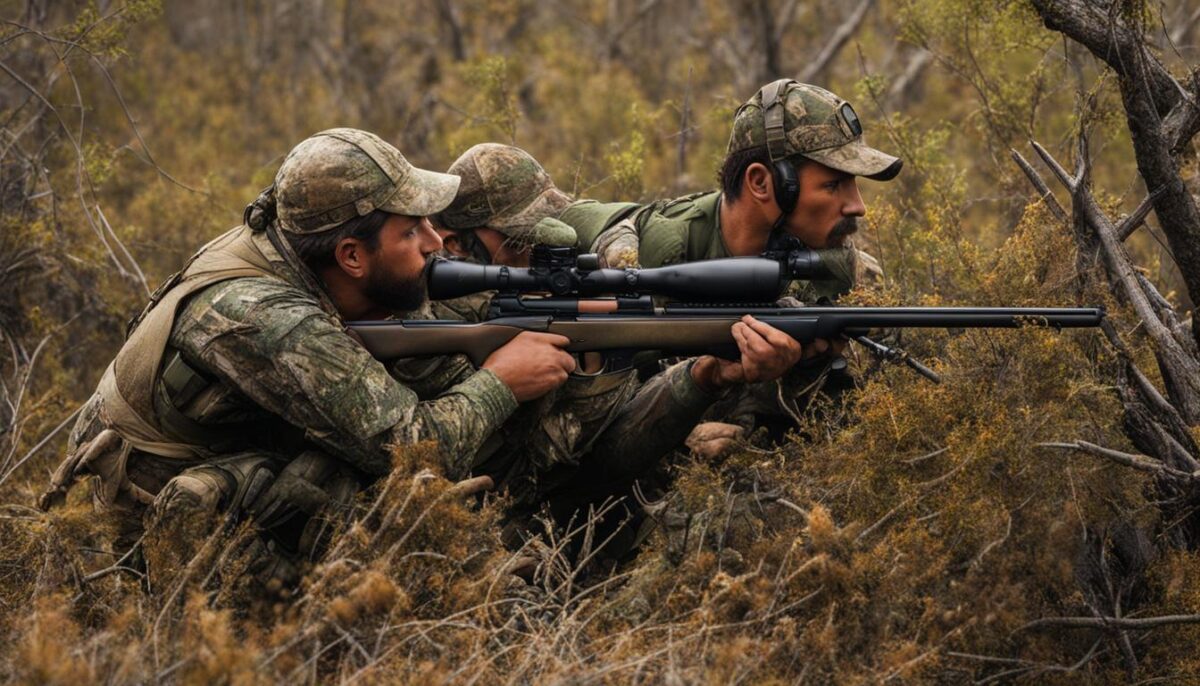
The Threats Posed by Feral Pigs
Feral pigs pose numerous threats to the environment, agriculture, and public health. They are voracious eaters and can destroy crops, compete with native wildlife for resources, and disrupt ecosystems. They are carriers of various infectious diseases that can spread to other animals, including livestock and humans. Unaltered male pigs grow long tusks, which can be a danger to humans and other animals. The economic impact of feral pigs is significant, causing billions of dollars in damage to property and agriculture each year.
The destructive feeding habits of feral pigs make them a serious threat to agriculture. They can decimate crops including corn, soybeans, and various fruits. In addition to eating the crops, they also damage the fields by rooting and trampling, causing soil erosion and degradation. This not only affects food production but also leads to negative environmental consequences, such as water pollution from runoff and loss of biodiversity in the affected areas.
Furthermore, feral pigs are carriers of various diseases that can have devastating effects on both animals and humans. Diseases such as brucellosis, leptospirosis, and tuberculosis can be transmitted from feral pigs to livestock and pose a significant risk to agricultural industries. Additionally, feral pigs can carry zoonotic diseases that can be transmitted to humans through direct contact, ingestion of contaminated food or water, or exposure to contaminated environments, leading to potential health hazards for humans.
The physical presence of feral pigs also poses risks to humans and other animals. Their large size and aggressive nature can result in conflicts with humans and domestic animals. The tusks of unaltered male pigs can cause serious injuries, and the potential for feral pigs to exhibit aggressive behavior can lead to dangerous encounters. These factors highlight the urgent need for effective feral pig management and control strategies to mitigate the threats they pose to both the environment and public health.
The Economic Impact of Feral Pigs
| Damage Caused by Feral Pigs | Financial Impact |
|---|---|
| Crop destruction | Billions of dollars in lost revenue |
| Damage to agricultural infrastructure | Millions of dollars in repair and maintenance costs |
| Contamination of water sources | Environmental cleanup costs |
| Healthcare expenses due to disease transmission | Medical treatment costs |
Feral Pig-Related Diseases and Transmission
- Brucellosis
- Leptospirosis
- Tuberculosis
- Salmonellosis
- Campylobacteriosis
- Toxoplasmosis
“The impact of feral pigs on agricultural production, natural ecosystems, and public health cannot be underestimated. Effective management and control measures are essential to mitigate the threats and economic losses caused by these invasive species.” – Dr. Jane Smith, Wildlife Biologist
Feral Pig Management and Control
Feral pig management involves a combination of lethal and nonlethal protocols to control and reduce their populations. These methods are aimed at preventing the spread of feral swine and minimizing their impact on the environment, agriculture, and public health.
Lethal Methods
Lethal methods are employed to eliminate feral pigs. Hunting and trapping are commonly used techniques to reduce their numbers. Hunting can be done by professional hunters or with the help of trained dogs. Trapping involves setting up baited traps to capture feral pigs, which can then be euthanized.
Nonlethal Methods
Nonlethal methods aim to deter and repel feral pigs from certain areas. These methods include the use of bad-tasting liquid sprays, water sprayers, and sound repellers. These tools make the environment uncomfortable for feral swine, discouraging them from staying in the area.
| Lethal Methods | Nonlethal Methods |
|---|---|
| Hunting | Bad-tasting liquid sprays |
| Trapping | Water sprayers |
| Poisoning | Sound repellers |
Efforts are being made to increase hunting opportunities and regulate game ranches that import boars for hunting. These measures help control the feral pig population, reduce their impact, and protect the interests of both the environment and human communities.
The Impact of Feral Pigs on Wildlife and Agriculture
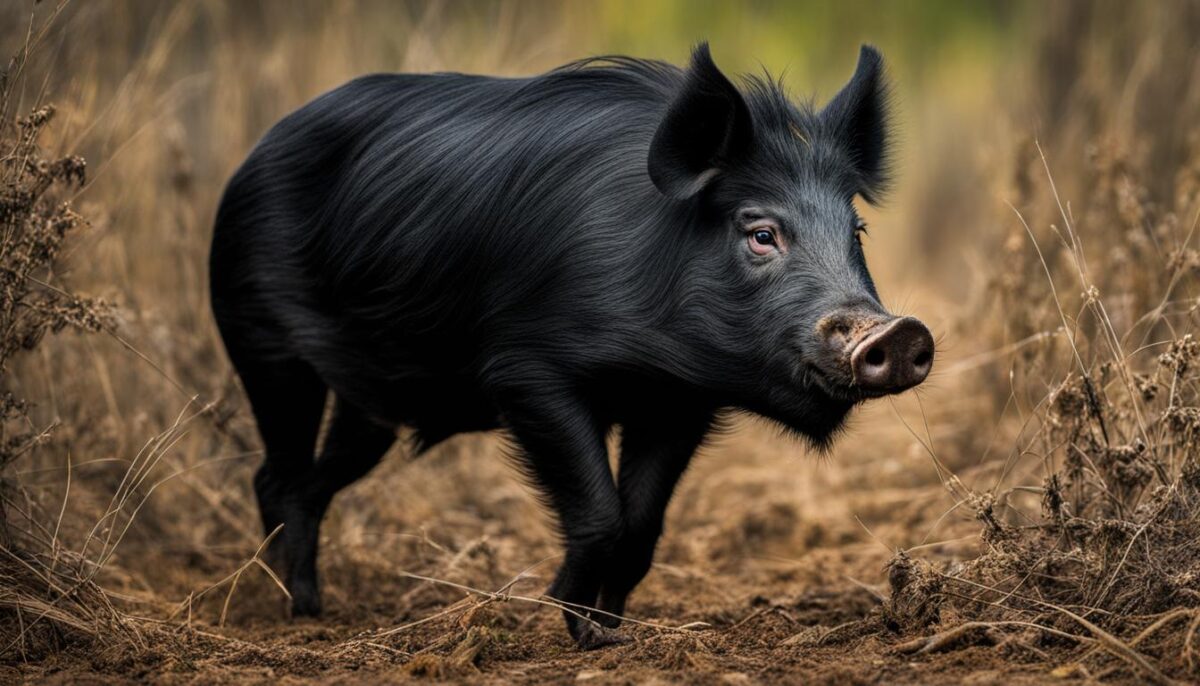
Feral pigs have a detrimental impact on both wildlife and agriculture. Their destructive foraging behavior disrupts native plant and animal habitats, leading to the degradation of ecosystems. Feral pigs root up land, trample vegetation, and eat the nests of ground-nesting birds, thereby reducing biodiversity and threatening the survival of native species.
In addition to the ecological consequences, feral pigs also pose a significant threat to agricultural interests. They cause extensive damage to crops such as corn and soybeans, leading to significant economic losses for farmers. Their voracious appetite and ability to adapt to various environments make them formidable pests in agricultural landscapes.
According to a study conducted by the USDA, feral pigs cause an estimated $1.5 billion in crop damage annually in the United States.
Efforts to manage and control feral pig populations are essential to protect both wildlife and agricultural interests. Lethal and nonlethal methods, such as hunting, trapping, and habitat modification, are employed to reduce their numbers and minimize their impact. However, the challenge lies in their high reproductive rate and adaptability, which necessitates ongoing surveillance and strategic management strategies.
The Ecological Impact
One of the key ecological impacts of feral pigs is their disruption of native plant communities. Their rooting behavior damages vegetation and soil structure, leading to soil erosion and the loss of important nutrients. This alteration of habitat structure can have cascading effects on other organisms within the ecosystem.
Feral pigs also compete with native wildlife for food resources, exacerbating the pressure on already vulnerable species. Their aggressive foraging habits can significantly impact the availability of food for other wildlife, leading to population declines and potential extinction.
The Agricultural Impact
The agricultural impact of feral pigs is a major concern for farmers across the United States. They not only destroy crops but also damage irrigation systems and fencing infrastructure. The economic losses incurred from feral pig damage can be devastating for small-scale farmers, who rely on their crops for their livelihood.
Furthermore, feral pigs can introduce diseases to livestock, posing additional risks to the agricultural industry. Diseases such as brucellosis and pseudorabies can be transmitted from feral pigs to domesticated animals, leading to illness and economic losses for livestock producers.
| Impact | Description |
|---|---|
| Ecological Impact | Disruption of native plant communities, soil erosion, competition with native wildlife for resources, population declines of vulnerable species |
| Agricultural Impact | Crop destruction, damage to infrastructure, introduction of diseases to livestock |
The Spread of Feral Swine in the United States
Feral swine populations in the United States have experienced a significant spread in recent years. From 1982 to 2020, the number of counties in southern states with feral pig populations increased from 544 to 1,915. What was once a localized issue has now become a widespread concern, as feral pigs have expanded their range inland and even reached states like Michigan and North Dakota. This rapid and extensive spread poses a substantial threat to ecosystems, agriculture, and public health.
The expanding range of feral swine has led to increased damage to crops, native wildlife, and natural habitats. These highly adaptable animals are known for their destructive foraging activities, which can result in soil erosion and contamination of water sources. Feral pigs not only compete with native species for resources but also disrupt entire ecosystems through their rooting and trampling behaviors. The economic impact of feral pig infestations is significant, causing billions of dollars in damage to property and agriculture each year.
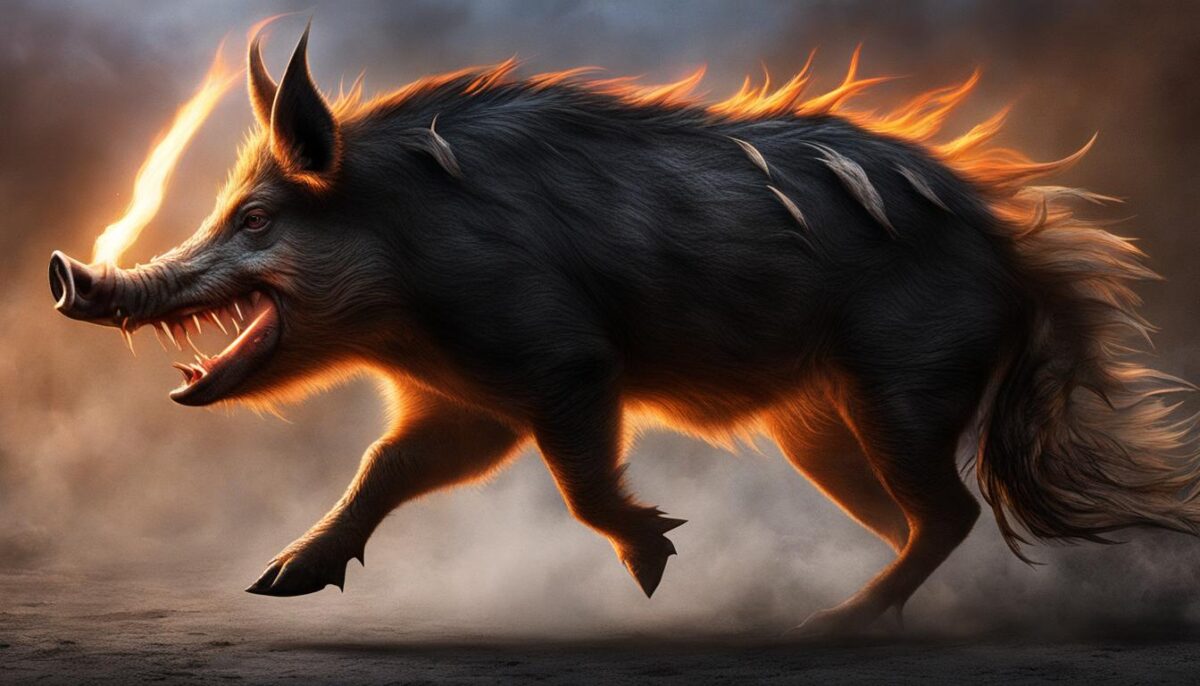 The image above illustrates the alarming spread of feral swine populations across the United States.
The image above illustrates the alarming spread of feral swine populations across the United States.
| Year | Number of Counties with Feral Pig Populations |
|---|---|
| 1982 | 544 |
| 2020 | 1,915 |
To combat the spread of feral pigs, various strategies are being implemented. These include efforts to prevent the establishment of self-sustaining populations, increased hunting opportunities, and regulations on game ranches that import boars for hunting. Additionally, feral pig management plans are being developed to control and reduce their populations through a combination of lethal and nonlethal methods. It is crucial to address the threat of feral swine and implement effective management strategies to prevent further damage to ecosystems, agriculture, and public health.
The Consequences of Feral Pig Infestations
Feral pig infestations have far-reaching consequences, impacting both the environment and human populations. These highly adaptable creatures disrupt ecosystems, destroy habitats, and threaten native species. Their rooting, trampling, and foraging activities contribute to soil erosion and the degradation of water sources. The ecological balance is severely affected as feral pigs compete for food with native wildlife and consume the nests of ground-nesting birds.
One of the most significant consequences of feral pig infestations is the damage caused to agricultural lands. Farmers suffer substantial economic losses as feral pigs destroy crops such as corn and soybeans. Additionally, their voracious appetite and destructive behavior make them a constant threat to livestock, posing risks to animal health and well-being.
Furthermore, feral pigs pose a risk to public health. They are carriers of various infectious diseases that can be transmitted to livestock, wildlife, and humans. Diseases such as pseudorabies and African swine fever can have devastating effects on commercial hog industries. The presence of feral pig populations increases the potential for the transmission of these diseases and the subsequent outbreaks that can occur.
The Impact of Feral Pig Infestations:
To fully understand the consequences of feral pig infestations, let’s take a closer look at the environmental, agricultural, and public health impacts:
| Environmental Impact | Agricultural Impact | Public Health Impact |
|---|---|---|
| – Disruption of ecosystems – Destruction of habitats – Soil erosion and water source contamination – Competition with native wildlife for food resources |
– Destruction of crops (e.g., corn, soybeans) – Economic losses for farmers – Threats to livestock health and well-being |
– Carriers of infectious diseases – Risk of transmission to livestock, wildlife, and humans – Potential disease outbreaks – Public health and safety concerns |
To mitigate the consequences of feral pig infestations, comprehensive management and control strategies are necessary. These may include a combination of lethal and nonlethal protocols, such as hunting, trapping, poisoning, habitat modification, and repellent measures. Efforts to prevent the establishment and spread of feral pig populations are crucial to protect the environment, agriculture, and human interests.
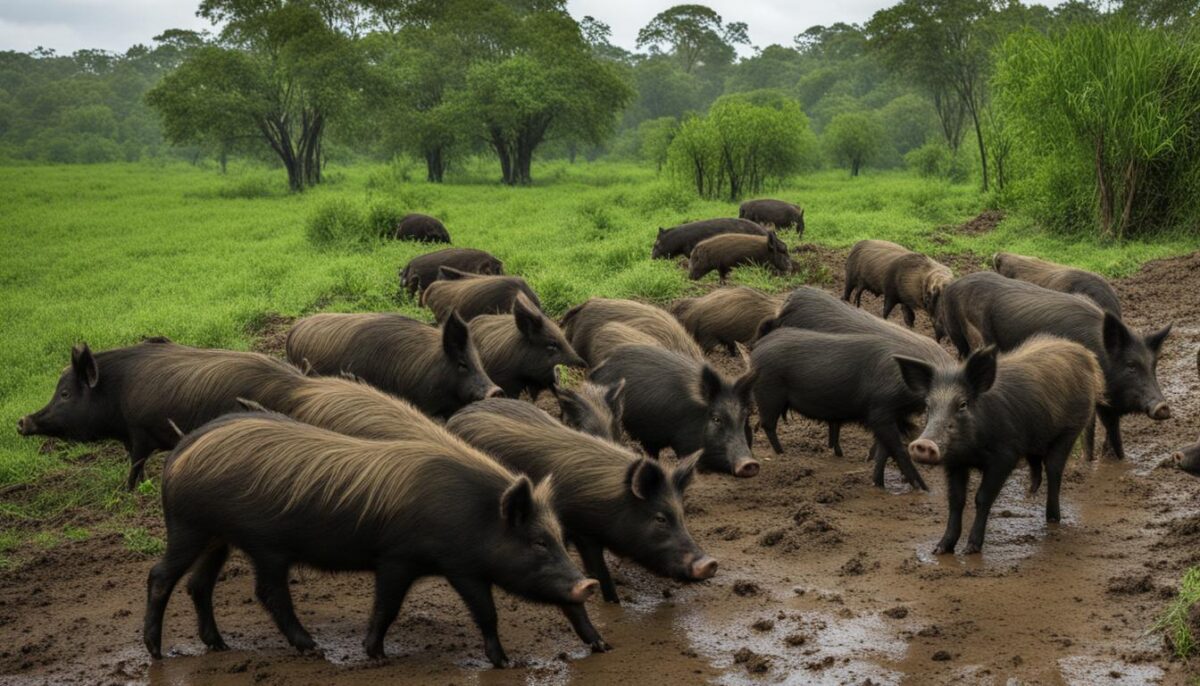
“Feral pig infestations have serious consequences for both the environment and human populations. They disrupt ecosystems, destroy habitat, and threaten native species.”
The Intelligence and Adaptability of Feral Pigs
Feral pigs are known for their remarkable intelligence and adaptability, which contribute to their success in the wild. These traits enable them to navigate diverse environments, find sources of food and water, and establish secure resting places. Feral pigs possess problem-solving skills and can quickly learn from their experiences, allowing them to overcome various challenges they encounter in their surroundings.
The adaptability of feral pigs is evident in their ability to thrive in different climates and landscapes. They can tolerate extreme weather conditions and adjust their behavior accordingly. For example, during periods of drought, feral pigs can locate water sources such as rivers, lakes, or even underground springs. They also have a keen sense of smell that helps them find food, even in the most challenging terrains.
Feral pigs’ intelligence and adaptability make them formidable opponents in efforts to control their populations. They can quickly learn to avoid traps and become wary of hunting techniques, making traditional management methods less effective. As a result, authorities and researchers are constantly exploring innovative strategies to minimize the impact of feral pigs on ecosystems, agriculture, and public safety.
“Feral pigs are highly intelligent animals that can outsmart many human attempts to control them. They are capable of adapting to new environments and learning from their interactions with humans, making them a significant challenge to manage.”
Efforts to manage and control feral pig populations require a comprehensive approach that considers the behavior and adaptability of these animals. This includes the development of advanced trapping techniques, the implementation of targeted hunting strategies, and the use of innovative technologies to deter feral pigs from specific areas. By understanding the intelligence and adaptability of feral pigs, researchers and experts can make informed decisions to address the challenges posed by these invasive species.
The Intelligence and Adaptability of Feral Pigs – Key Points:
- Feral pigs possess remarkable intelligence and adaptability, enabling them to thrive in the wild.
- They are capable of problem-solving and learning from their experiences, making them adept at overcoming challenges in their environment.
- Feral pigs can adjust their behavior to different climates and landscapes, ensuring their survival in diverse conditions.
- Their intelligence and adaptability make feral pigs difficult to control using traditional management methods, requiring innovative strategies to minimize their impact.
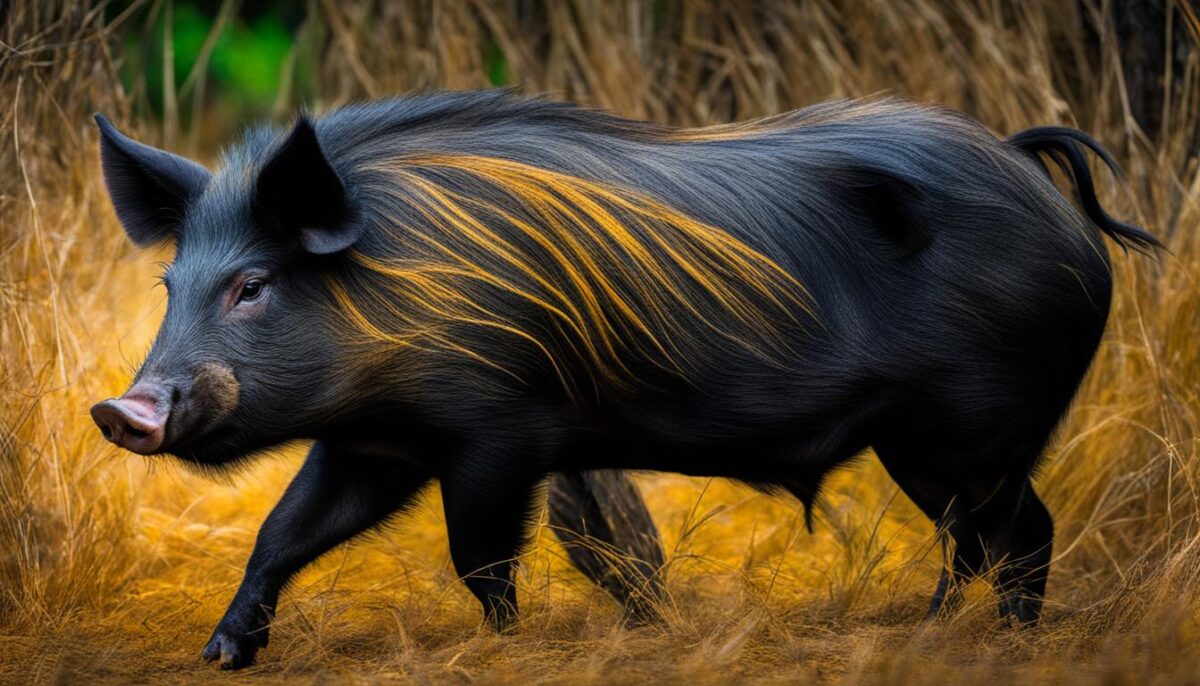
| Key Characteristics | Implications |
|---|---|
| Problem-solving skills | Feral pigs can quickly adapt to new situations, making traditional management methods less effective. |
| Adaptability to different environments | Feral pigs can survive in diverse landscapes, making it challenging to control their populations. |
| Learning from interactions | Feral pigs can recognize and avoid traps, making targeted hunting strategies necessary. |
| Sense of smell | Their keen sense of smell helps feral pigs locate food and water sources even in harsh terrains. |
The Risk of Feral Pig Diseases
Feral pigs, while causing significant damage to ecosystems and agriculture, also pose a considerable risk in terms of disease transmission. These animals act as carriers for various diseases, which can have devastating effects on livestock, wildlife, and even human populations. In particular, diseases such as pseudorabies and African swine fever are of great concern due to their potential impact on commercial hog industries.
One of the most significant risks associated with feral pigs is the transmission of diseases to domestic pig populations. When feral pigs come into contact with domestic pigs, there is a high likelihood of disease transmission, leading to outbreaks that can severely impact the hog industry. This not only results in economic losses but also poses a threat to food security.
Efforts to control and manage feral pig populations are crucial in mitigating the risk of disease transmission. By reducing the number of feral pigs and implementing preventive measures, such as strict biosecurity protocols, the likelihood of disease outbreaks can be minimized. Additionally, ongoing surveillance and monitoring programs can help identify and address disease hotspots, allowing for targeted interventions.
Table: Diseases Associated with Feral Pigs
| Disease | Impact |
|---|---|
| Pseudorabies | Highly contagious viral disease that affects multiple species, including pigs, cattle, dogs, and cats. Can lead to reproductive failure and high mortality rates in affected animals. |
| African Swine Fever | A viral disease with no known cure or vaccine. Causes high fever, internal bleeding, and ultimately death in infected pigs. |
| Brucellosis | Bacterial infection that can cause reproductive failure in pigs. Also poses a risk to human health as it can be transmitted through contact with infected pigs or consumption of contaminated meat. |
| Leptospirosis | Bacterial disease that can affect many species, including pigs. Can lead to reproductive problems, liver damage, and kidney failure in affected animals. |
Addressing the risk of feral pig diseases requires a multi-faceted approach that combines population control strategies with disease surveillance and biosecurity measures. By implementing these measures, we can protect the health and well-being of both domestic livestock and human populations.
Conclusion
The transformation of domestic pigs into feral hogs is a fascinating process that involves genetic factors, environmental conditions, and behavioral adaptations. Feral pigs, also known as feral swine, have the potential to cause significant damage to ecosystems, agriculture, and public health.
To mitigate the impact of feral pigs, it is crucial to implement effective feral pig management strategies. These strategies include both lethal and nonlethal protocols to control and reduce their populations. Efforts are also being made to increase hunting opportunities and regulate game ranches that import boars for hunting.
Preventing the spread of feral swine requires a comprehensive and coordinated approach. This includes feral pig extermination, feral pig habitat modification, and wild hog prevention. By addressing the threat of feral pigs, we can protect the environment, preserve agricultural interests, and safeguard human health.
Controlling feral pig populations is a complex task, but by implementing these management strategies, we can reduce the impact of feral pigs and prevent further damage. It is essential that we continue to work towards feral pig population control to ensure a balanced and sustainable ecosystem for future generations.
FAQ
What are feral swine?
Feral swine are formerly captive pigs that have reverted to the wild. They can be Eurasian boars or other exotics that have escaped from game ranches. Domestic hogs or hybrid breeds can also become feral.
How do pigs become feral?
When pigs live in a wild environment, genes from their wild ancestors are switched on, resulting in the pig becoming feral. Hormonal changes and behavioral adaptations also contribute to the transformation from domesticated pig to feral hog.
What damage do feral swine cause?
Feral swine cause damage to crops, wildlife, and the environment. They trample, forage, and root up land, causing erosion and habitat destruction. They also compete with native wildlife for resources and carry infectious diseases that can spread to livestock and humans.
How are feral pig populations controlled?
Feral pig management involves a combination of lethal and nonlethal protocols such as hunting, trapping, poisoning, and habitat modification. Efforts are also being made to increase hunting opportunities and regulate game ranches that import boars for hunting.
What impact do feral pigs have on wildlife and agriculture?
Feral pigs disrupt native plant and animal habitats, destroy crops, eat ground-nesting bird nests, and compete for food sources with native wildlife. They also cause soil erosion and contaminate water sources. In agriculture, they cause extensive damage to crops such as corn and soybeans.
How has the spread of feral swine affected the United States?
Feral swine populations have been spreading across North America, reaching states like Michigan and North Dakota. This expansion poses a significant threat to ecosystems, agriculture, and public health.
What risks do feral pigs pose to human health?
Feral pigs are carriers of various infectious diseases that can spread to other animals, including livestock and humans. They can also be dangerous due to their long tusks, which can cause harm to humans and other animals.
How intelligent and adaptable are feral pigs?
Feral pigs are highly intelligent and adaptable animals. They can quickly learn and adjust to their surroundings, making them highly successful in the wild. This adaptability contributes to their invasive nature and makes them difficult to control.
What is the risk of feral pig diseases?
Feral pigs are carriers of various diseases that can have devastating effects on commercial hog industries. The presence of feral pig populations increases the potential for the transmission of these diseases to domestic pigs, posing a risk to both animal and human health.


